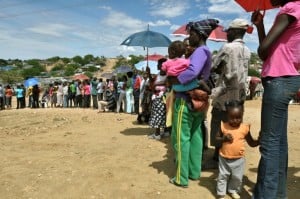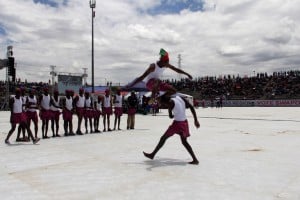This article is more than 9 years old
Namibia went to the polls on 28 November 2014, the country’s fifth national election since independence in 1990. Namibians cast two ballots: one for their party for seats in the National Assembly and another for their choice of president. And to say the country's ruling South West Africa People's Organisation (Swapo) won – well, that would be understating things. Dramatically.
Why this election was important
Namibians voted electronically this year – a first for the continent.
The elections also ushered in a new president in the form of Hage Geingob, the current prime minister and Swapo candidate, who steps into the role off the back of a massive win in the presidential race.
His predecessor Hifikepunye Pohamba bows out after two terms in power.
Who voted

About 1.24-million people registered to vote. It may not seem like a lot, but Namibia is one of the world’s most sparsely populated countries. According to the World Bank, it has a population of just over 2.3-million.
Slightly more women were registered to vote than men, according to the Electoral Commission of Namibia, but the real difference came down to age.
About a fifth of the total registered voters were “Born Frees”, the term used to describe those born after Namibia’s independence on March 20, 1990.
Stretch that a little further back and your Generation Y voters, born in the 1980s and beyond, made up 45.5% of the registered vote.
Baby Boomers only accounted for 16% of registrations, and Generation X of the '60s and '70s sat at 32%.
In the end, more than 890,000 Namibians voted, giving the elections a turnout of around 72%, up about four percentage points from the 2009 elections.
“It is our considered view that the high voter turnout realised is testimony of the outreach of our voter and civic education and the enthusiasm Namibians had to use the Electronic Voting Machines (EVMs) for the first time,” Electoral Commission of Namibia chairperson Notemba Tjipueja said.
Who contested the elections
Sixteen parties contested seats in the National Assembly, including a Namibian incarnation of the Economic Freedom Fighters (NEFF), which the Mail & Guardian reports comes complete with red berets, overalls, calls for nationalisation – and a strong homophobic streak.
Of those 16, six didn't get a single seat in the National Assembly, including the NEFF.
Nine parties put forward presidential candidates, including ruling party Swapo and the two main opposition parties, the Rally for Democracy and Progress (RDP) and Democratic Turnhalle Alliance (DTA).
Past results

In the previous four elections, Swapo won about 75% of the seats in the National Assembly, with its presidential candidates – Sam Nujoma in '94 and '99, and Pohamba in '04 and '09 – pulling in around the same, give or take a few percentage points.
The opposition make up the rest, but that share becomes more fractured with each election. A 23.7% haul for the DTA in 1994 was worn down over the years to single digits.
And the RDP, which burst onto the scene in 2009, became the official opposition with only 11.3 percent pulling power.
What did each of the parties stand for?
Swapo’s election campaign leaned heavily on the past. The ringing chorus throughout the party’s manifesto was: “We have a sound track record!”
It cited examples of law reform, sustained growth rates of above 4% since 2010, reduced poverty levels and increased access to housing, electricity, education.
“We brought freedom; there’s peace in the country. At independence we only had a few schools now they are many; clinics and health centres have been built and there is potable water and electricity,” the Deputy Minister of Information and Communication Technology, Stanley Simataa, said at a party rally before the elections. “All that was brought by the Swapo government not the opposition… Why do you vote for parties that are already dead?”
The opposition was less enthusiastic about these claims, pointing to unsolved unemployment, stagnant economic growth, struggling business and a lack of housing. They lamented poor working conditions for police, attempts to stifle the media, and faltering parastatals.
“It’s time for change,” said the RDP, an offshoot of Swapo which was formed in 2007. Its campaign slogan was: “Together we can do better.”
“Save our democracy,” cried the DTA. “Break the two-thirds majority.” They also promised to do everything from lowering taxes to creating a buffer zone between Angola and Namibia for a “more secure disease free zone”.
The DTA also made it known it wanted to reclaim its place as the official opposition – and it did.
Hot button topics

A key concern for many in this election was a set of Constitutional reforms pushed through earlier this year, including the introduction of a second vice president to provide some ethnic balance in government and a 50/50 gender rule in the National Assembly – a move celebrated by some but which may be flawed in implementation. It’s not as simple as splitting the 72 available seats half way. Instead, an extra 24 seats have been added.
“It was felt that many of the senior Swapo cabinet were older males, who were not ready to retire, and might have been at risk of losing their seats without the parliamentary expansion,” noted Afrobarometer.
A study the organisation conducted found 59% of respondents felt the changes were pushed through without adequate public consultation – and that included Swapo supporters: 55% of them.
Smaller parties accused their larger counterparts of buying votes with food, while the RDP said it wanted the UN to observe the elections.
Even the electronic voting machines (EVMs) – over 4,000 of which were used and which have brought so much positive attention to this election – were controversial.
Visually impaired voters raised concerns about how easily they would be able to use the machines.
“The main advantages of EVMs are simplicity of the procedure, the ease of tabulation of ballots into results and the faster and more accurate results,” read an editorial in the Namibian Sun in June. “Disadvantages include virus infection, vulnerability to hacking, as well as physical tampering… If we are not ready, we should stick with the trusted paper ballots.”
And just days before the elections, the RDP together with NEFF and the Workers Revolutionary Party (WRP) tried to have the elections postponed, arguing in court that the machines didn’t print out receipts as specified in the country’s new electoral act, and so did “not produce a verifiable paper trail for every vote cast by the voter”. The High Court in Namibia’s capital Windhoek dismissed the legal challenge.
The Electoral Commission is less concerned: it said it has used the machines in five by-elections without incident.
Election day

As it turns out, the opposition parties' fears were not unfounded.
Technical and user difficulties with the electronic registration and voting machines resulted in long, crawling queues across the country. In other areas, the mobile polling stations simply didn't arrive.
Politicians from across the board expressed their concerns.
“The ECN leadership, including the director should volunteer and resign so that they can be replaced with patriotic Namibians who will fulfil their duties,” said one Swapo regional leader, Armas Amukwiyu. “I strongly condemn the manner in which ECN officials handled the polling stations.”
Observers from the African Union and the Southern Africa Development Community echoed the concerns raised – but still gave the elections their “free and fair” stamp of approval.
The results
There was little doubt that this year would see another big win for Swapo. And unlike other long-standing but faltering liberation-turned-ruling parties in the region – like South Africa’s ANC and Ian Khama’s Botswana Democratic Party – they walked away from the elections stronger than ever, amassing an incredible 80% of the vote.
Geingob won the presidency even more spectacularly with 87%.
The party's 5 percentage point bump wasn't a complete surprise: studies ahead of the elections had shown Swapo was enjoying strong support across the country.
It now has 77 of the 96 elected seats in the National Assembly, an overwhelming majority.
The DTA nearly doubled its voters from about 25,000 in 2009 to 43,000 this year – but that still only made up 4.8% of the vote, leaving Namibia's official opposition with just 5 seats in the National Assembly.
The RDP fell spectacularly from 11.31% in 2009 to 3.51% this year.
You can find the full results here.
How Namibians reacted on Twitter
Teething problems & all - I salute @ECN_Namibia for pioneering the first electronic vote in Africa. I'm a proud Namibian. Well done ECN!
— HashtagTashia (@TashiaKalondo) December 2, 2014
Number of women in parliament will increase from 26% currently, to 42% in next National Assembly. It's not 50/50, but it's a big improvement
— electionwatchnamibia (@electionwatchna) December 1, 2014
Leader of the DTA, the new official opposition, @mvenaani, vows to keep the government on its toes. #NamVotes2014
— Jean Sutherland (@JeanNamibian) December 1, 2014
A boon for Swapo. A blow for democracy. #NamElections2014
— Gwen Lister (@GwenLister1) December 1, 2014
You want change but you continue voting for the status quo. We get the leaders we deserve #NamElections2014
— Milly K (@NamGoddess) December 1, 2014
Delivery is key to keeping your mandate to rule. We have spoken, loud and with no doubt! #Namibiavotes
— allyangula (@allyangula) December 2, 2014
Kristen van Schie is a southern Africa correspondent for Agence France Presse (AFP), based in Johannesburg, South Africa.


Add new comment